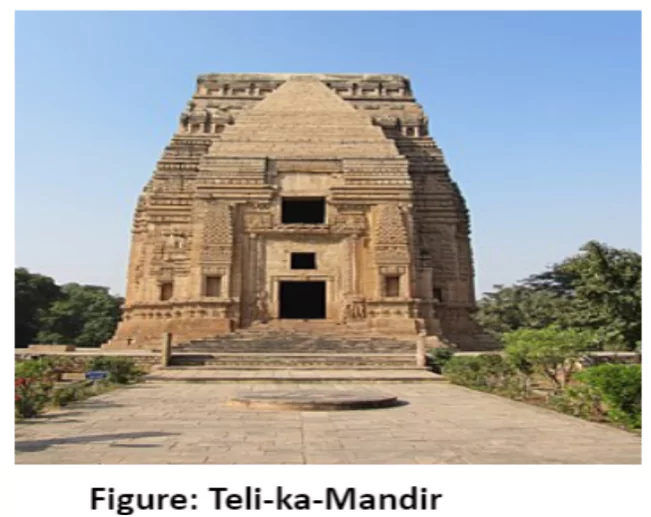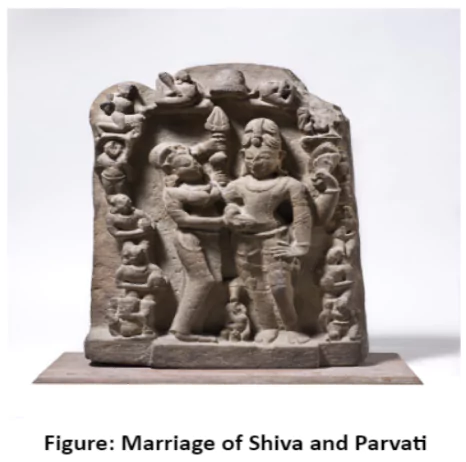The Gurjara-Pratihara rulers of ancient India were renowned for their patronage of arts, architecture, and literature. Led by notable rulers like Mihir Bhoj, they left a lasting legacy of cultural richness and architectural marvels. Notable sculptures and beautifully carved temple panels attest to their dedication to artistic excellence.
An Overview of Gurjara-Pratihara Art and Architecture:
1. Evolution of Architecture:
- Shows progression from early forms to more elaborate and sophisticated structures.
- Gurjara-Pratihara rulers were patrons of arts, architecture, and literature.
- Mihir Bhoj was a notable ruler of the dynasty.
- Notable Sculptures: include Viswaroopa form of Vishnu and Marriage of Siva and Parvati from Kannauj.
- Exquisite Temple Wall Carvings: Beautifully carved panels seen on temple walls at Osian, Abhaneri, and Kotah.
- Early Works at Osian: Five-bay mulaprasadas, often with porch and open hall. Some have five-shrine complexes.
- Walls usually feature ghana-dwaras and vedika.
- Pillars often had purna-kalasha capitals, and ceilings evolved from flat slabs to corbelled with carvings.
2. Architecture

- Roda: Features mulaprasadas without ambulatory, with a porch and sometimes a platform with socles.
- Teli-ka-Mandir: oldest surviving large-scale Pratihara work at Gwalior.
- Elevated rectangular mulaprasada with double oblong shikhara and closed portico.
- Walls often had relief carvings, and the temple architecture showcased varied elements like Phamsana roofs and purna-kalasha pillars.
- Baroli Temple: Features Phamsana roofs, elaborate aedicule, and miniature Latin shikhara.
- Gyaraspur Temple: advanced in plan, with ambulatory, vestibule, and closed hall.
- Ambika Matha at Jagati: Exquisite synthesis of various elements, including mulaprasada, Phamsana roofs, and elaborately carved pillars.
- Kiradu Temples: Representative of the sumptuous culmination of the Pratihara tradition. Vishnu Temple is notable for its Samvarana roof.
- Patronage of Arts and Culture: Gurjara-Pratihara rulers were patrons of arts, architecture, and literature, with Mihir Bhoj being the most outstanding ruler of the dynasty.
 Sculptural Masterpieces: Notable sculptures from this period include the Viswaroopa form of Vishnu and the Marriage of Shiva and Parvati from Kannauj.
Sculptural Masterpieces: Notable sculptures from this period include the Viswaroopa form of Vishnu and the Marriage of Shiva and Parvati from Kannauj.- Architectural Marvels: Temples in Osian, Abhaneri, and Kotah feature beautifully carved panels on their walls.
- Advancement of Religion: This period witnessed the advancement of the Brahmanical religion, with Vaishnava, Shaiva, and Surya being prominent sects.
- Support for Temple Construction: Kings and affluent individuals supported temple construction and statues, considering it a sacred duty.
- Worship of Shaiva Deities: Worshippers of the Shaiva religion revered Siva under various names like Indra, Sankar, Pashupati, Yoga swami, and Shambhu.
Enroll now for UPSC Online Course
3. Literary Contributions:
- Rajashekhara, the court poet of the Gurjara Pratiharas.
- He was a renowned Sanskrit poet, dramatist, and critic who wrote the practical guide for poets, Kavyamimamsa, and the play Karpuramanjari in Sauraseni Prakrit to honor his wife, Avantisundari.
Conclusion
The Gurjara-Pratihara dynasty stands as a testament to the flourishing of arts and culture in medieval India. Through their patronage, they fostered an environment where creativity thrived, leaving behind a rich heritage of sculptural masterpieces and architectural marvels. Their legacy continues to fascinate and inspire generations, highlighting the enduring power of artistic expression and cultural preservation.
![]() May 14, 2024
May 14, 2024
![]() 3234
3234
![]() 0
0

 Sculptural Masterpieces: Notable sculptures from this period include the Viswaroopa form of Vishnu and the Marriage of Shiva and Parvati from Kannauj.
Sculptural Masterpieces: Notable sculptures from this period include the Viswaroopa form of Vishnu and the Marriage of Shiva and Parvati from Kannauj.